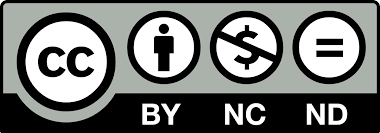Research Article | Vol. 5, Issue 3 | Journal of Clinical Medical Research | Open Access |
Intra-Vertebral Contrast Phlebography During Balloon Kyphoplasty: A Cautionary Tale of Using Antegrade Inferior Vena Cavogram in Preventing Pulmonary Cement Embolism
Melissa Kohner1




1Great Lakes Bay Health Centers, Bay City MI, USA
2Swanson School of Engineering, University of Pittsburgh, Pittsburgh PA, USA
3Department of Neurosurgery, Garden City Hospital, Garden City, Michigan, USA
4Government Medical College Kozhikode, Kerala, India
*Correspondence author: Sunil Manjila, MD, Department of Neurosurgery, Garden City Hospital, Garden City, Michigan, USA; Email: [email protected]
Copyright© 2024 by Kohner M, et al. All rights reserved. This is an open access article distributed under the terms of the Creative Commons Attribution License, which permits unrestricted use, distribution, and reproduction in any medium, provided the original author and source are credited.
Citation: Kohner M, et al. Intra-Vertebral Contrast Phlebography During Balloon Kyphoplasty: A Cautionary Tale of Using Antegrade Inferior Vena Cavogram in Preventing Pulmonary Cement Embolism. Jour Clin Med Res. 2024;5(3):1-8.
| Received 13 December, 2024 | Accepted 25 December, 2024 | Published 31 December, 2024 |
Abstract
Pulmonary embolism of cement is considered a catastrophic complication of kyphoplasty. Considering the predilection of thoracic and upper lumbar levels as well as the role of valveless vertebral plexus and abdominal caval system, we report the utility of performing an intra-osseous phlebography in the fractured vertebral body visualized through lateral view fluoroscopic cine-images to assess the direct contrast efflux towards the Inferior Vena Cava (IVC). The flow patterns of anterior external vertebral venous plexus and its tributaries are shown using schematic diagrams and fluoroscopic images. Stepwise technique of this perivertebral venogram is discussed as well as recognition of confounding paravertebral/ radiculomedullary arterial anatomy. The new venous channels opening up after balloon inflation are highly likely to be the surrogate pathways for cement embolization to the heart and pulmonary artery. This simple additional imaging step (“antegrade inferior vena cavogram”) helps to avoid anterior venous plexus extravasation of cement towards the IVC, using bipedicular contrast lavage and sequential injection using different viscosities. This article also highlights the management of pulmonary embolism using interventional radiology as well as open surgical methods. The article also eludes into some alternate vertebral augmentation device strategies to achieve complete obviation of cement extravasation as well.
Keywords: Vertebral Phlebography; Contrast Venogram; Balloon Kyphoplasty; Pulmonary Embolism; Cement Extravasation
Abbreviation
IVC: Inferior Vena Cava; VCF: Vertebral Compression Fractures; PCE: Pulmonary Cement Embolism; PMMA: Polymethylmethacrylate; PTE: Polyethylene Terephthalate; CFK: Catheter Fabric Kyphoplasty
Introduction
Over the past decade, there is a surge of evidence about fast and sustained pain relief, reduced use of pain medication and improved mortality after kyphoplasty in Vertebral Compression Fractures (VCF) [1-8]. Vertebroplasty, kyphoplasty, lordoplasty and stentoplasty are effective minimally invasive treatments reported in literature for stable vertebral compression fractures without compression of the spinal cord or neural foraminal structures. Luginbhul, et al., in 2020 published a review citing 4.6-6.8 % incidence of asymptomatic pulmonary cement embolism depending on cement viscosity, injection pressure and number of injected vertebrae treated [9-11]. Wang, et al., cite kyphoplasty safety studies finding an occurrence of cement embolisms 8%-33% with 0.5%-4% of those cases being symptomatic, with less than 3% chance of PCE [10,18]. Martin Lopez JE in 2015 reported in a level II systematic review that stentoplasty is comparable to kyphoplasty in terms of kyphosis correction, radiation exposure and cement extravasation [12]. Agko, et al., cites the same occurrence of reported cement leakage as a complication of kyphoplasty (8.6%-33%) and 30%-75% for vertebroplasty [1]. Agko, et al., additionally cites the risk for pulmonary embolism as being 0.4% for kyphoplasty and 0.9% for vertebroplasty [1].
Pulmonary Cement Embolism (PCE) is caused by cement leak into the paravertebral venous system then into the pulmonary artery via the azygos vein [14-17]. Subsegmental fragments are often asymptomatic, while a large central embolism in pulmonary artery or a saddle embolism causing cardiac issues get symptomatic faster. There has not been any age or sex predilection for pulmonary cement embolism, hence the anatomical factors (bone mineral density, anterior cortex fracture, large basivertebral vein etc), injection technique (large volume, high pressure etc), biomaterial characteristics of the cement (viscosity, prothrombotic nature etc), presence of Inferior Vena Cava (IVC) filter etc are crucial [1]. The relevance of venous drainage of vertebral bodies with respect to kyphoplasty has been recently published by Iwanaga, et al., in an anatomical study [7]. Considering that the reported cases of PCE in literature arose in mostly thoracic and upper lumbar vertebral fractures, the venous drainage is shared between between valveless vertebral plexus and abdominal caval system and no vessel imaging is typically performed before balloon kyphoplasty in regular VCF, we feel that any intraoperative phlebographic information can be used as a test for identifying surrogate venous channels that can potentially lead to pulmonary embolism. We report a patient who underwent a pre-cementing phlebography of VCF where a persistent contrast efflux was seen into the inferior vena cava, which was getting filled via prevertebral or paravertebral venous plexus (Fig. 1).
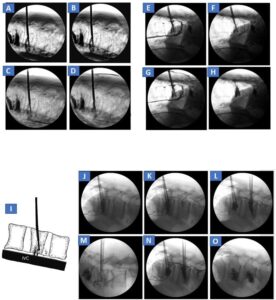
Figure 1: A-D: The kyphoplasty cannula is inserted into the vertebral body in a transpedicular route, after verifying the level of fracture fluroscopically. The contrast injection revealed a remarkable swift egress of contrast into the Inferior Vena Cava (IVC), through bridging vein(s) in the prevertebral/ paravertebral region, draining into the IVC, Delayed fluoroscopic images show the efflux of contrast from the IVC towards the heart. Images E-H show the bipedicular access at the same vertebral level, E showing venous drainage in the perivertebral area, F revealing status post unilateral balloon inflation, G: phlebogram via contralateral pedicle showing more venous anatomy visualized in the spinal canal and H showing viscosity-adjusted cement delivery with no radiological evidence of local extravasation. Image I showing a schematic diagram explaining the path of cement leaving the vertebral body via draining veins to inferior vena cava. This can lead to right atrium, pulmonary vessels. Images J to O show the balloon inflation can lead to increased visualization of new venous channels while treating multiple VCF levels. Image J shows upper level of VCF accessed bipedicularly, minimal stagnation of pervertebral venous drainage, K showing minimal venous structures seen in spinal canal and L showing completion of kyphoplasty. Image M shows access to inferior level vertebra suing bipedicular access and increased visualization of veins in the spinalcanal in N and cautious cement delivery into the vertebral body without extravasation in image O.
Ethical Statement
The project did not meet the definition of human subject research under the purview of the IRB according to federal regulations and therefore was exempt.
Illustrative Case:
This 76-years old lady with known osteoporosis presented with midthoracic back pain and MRI scan showed three contiguous acute vertebral body fractures in T7-9 levels. Contrast venogram in this case before balloon inflation showed direct filling of inferior vena cava, possibly via draining tributaries. This radiological finding warned us about the patent venous drainage that could be a surrogative conduit for fast transit of cement into the IVC. Once a flash visualization of IVC was noted in a standard transpedicular contrast injection, another 3-cc continuous slow injection of Omnipaque -250 was used under live fluoroscopic imaging (Fig. 1) We aborted further balloon inflation and chose to use a hyperviscous, low volume, low pressure contrast injection initially, to create an intracavitory lining, followed by remaining lower viscosity cement after waiting for 30 seconds. 3 cc of Kyphon high viscosity bone cement was used at this level and the procedure was completed without any extravasation of bone cement at any level.
Anatomy of Vertebral Venous Plexus and Relationship to Inferior Venacava
Extracorporeal venous architecture in thoracolumbar spine is very complex, especially with the communication to Batson’s plexus and azygous system of veins. The paravertebral venous plexus comprises of the anterior and posterior internal and external venous plexuses which are in communication with each other (Fig. 2,3) A basi-vertebral vein in median location is suggested as one of the anatomic variants when hypertrophic, that predispose to embolism of cement [19]. This vein eventually communicates with epidural veins, prevertebral veins and the inferior vena cava via azygous veins or lumbar paraspinal veins independently. The inferior vena cava is formed at the L5 vertebral body level anteriorly and then lies retroperitoneal to the right of midline. Then it pierces diaphragm at level of T8 vertebral body. Importantly, these venous tributaries should not be confused with the radiculo-medullary artery – which is smooth, less tortuous and follows a definite path extending from anterior vertebral body wall posteriorly to the neural foramen, beneath the pedicle of the same vertebra.
Reports from vertebroplasty literature recommend a maximum of 4-5 cc cement per vertebral level and a maximum of 6 levels treated per session with a maximum 20-30 cc PMMA. Wang et al showed that kyphoplasty performed on 4 or more vertebral levels was not found to increase risk to patient safety and it might decrease unnecessary risks associated with multiple operations and anesthesia sessions [18].
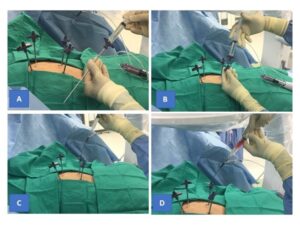
Figure 2: A: Contrast syringe loaded with 5 cc Omnipaque 250 in homolateral pedicle while the contralateral pedicle has kyphoplasty balloon positioned in situ; B: Saline irrigation through the cannula is undertaken if the contrast stagnation is noted within the vertebral body; C: Contralateral pedicle is then accessed through the cannula, the above procedure is repeated. Often times, the saline will emerge through the contralateral cannula on ipsilateral injection, like a vertebral “lavage” reported in vertebroplasty literature, showing occasionally bloody return as in D: Sometimes some persistent vertebral body bleeding can be seen, especially in acute fractures, however the cement injection will seal the fracture site to achieve hemostasis, however should be done with extreme caution under fluoroscopic imaging.
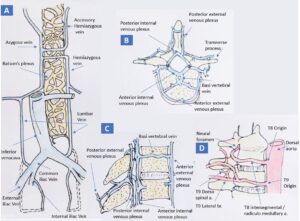
Figure 3: A: Schematic diagram of venous drainage to inferior venacava (corresponding to T8-L5 vertebral levels), with relation to the azygous system which handles most of the drainage from paravertebral veins; B. The anterior and posterior external and internal confluence of veins and the basivertebral median vein are depicted in drawing of axial plane; C: sagittal view depicting the same anatomy of perivertebral plexus, especially the corresponding venous anatomy which is crucial during intraoperative phlebography – “ inferior vena cavogram” due to tributaries leading from the fractured vertebral body. Of note, understanding the venous anatomy can help plan cement injection via contralateral pedicle (in bipedicular access) and in adjacent levels (especially in multilevel fractures needing cement augmentation) can help preventing inadvertent cement extravasation at those levels; D: Spinal arterial anatomy that helps identifying a segmental radiculomedually artery seen on the lateral fluoroscopic image as a vessel, less tortuous and following the anatomy from anterior vertebral body to the neural foramen, unlike venous drainage.
Antegrade Cavogram Technique via Vertebral Phlebography
As a part of balloon kyphoplasty, the Jamshidi needles are inserted into the pedicles under AP and lateral fluoroscopy in a standard fashion. Then 2 cc of undiluted Omnipaque-250 contrast is injected through each pedicle into the vertebral body. This can be started with the homologous pedicle via 12.8 mm inner diameter cannula (Medtronic Inc, MN) and Expander II balloon which has a hollow stylet. Then contralateral pedicle is then accessed for contrast phlebogram. The speed of contrast injection can be increased if there is non-opacification of bridging veins. One should carefully look for de novo venous channels that open up after balloon inflation. If there is contrast -visualization of bridging veins, extreme caution should be exercised and the use of sequential injections – hyperviscous, low volume, low pressure contrast injection initially- is recommended, followed by serial fluoroscopic imaging (or cine fluoroscopy), at 30 seconds and again at 1 minute. These delayed images would show the focal extravasation of cement if any. Once the intra-cavitory cement is formed into a thin shell lining the void, further injection of less viscous, small amount, low pressure injection can be continued with serial imaging [4].
If there is significant extravasation seen in lateral and AP view, a delayed 2 min and 5 min fluoroscopic images are taken to ensure that the distal cement flow is not entering the IVC. If there is clear evidence of systemic migration of prevertebral cement into IVC, a chest fluoroscopic image is also done to screen for cement, however the radiologic differential diagnosis includes a calcified granuloma eroding into the pulmonary artery, calcified lymph node and a calcified thrombosed pulmonary artery aneurysm. Hence a CT chest/ abdomen would be the next prudent step.
Of note, AP view is unreliable due to overlap of bony anatomy and inadequate visualization of bridging veins draining antegrade to IVC. Irrigation of contrast and saline into the vertebral body is considered a generous vertebral body “lavage”, before injecting cement (Fig. 2) [6]. The contrast venogram technique can display varied patterns of venous opacification in acute spinal trauma cases compared to regular osteoporosis.
We advocate pre- ballooning and post- ballooning contrast venogram in order to understand the opening of newer channels as a result of ballooning itself. Many would consider these a superfluous step, as they would follow a logical and cautious differential-viscosity cement injection regardless of high-risk venous anatomy. With added information, the injection velocity modulations can be done better during injections of the same and adjacent levels respectively (Fig. 1) There are contradicting opinions on the efficacious use of vertebral phlebography in the early vertebroplasty literature, despite higher risk of PCE compared to balloon kyphoplasty. Some believe that the pre-cementing venography does not reliably predict contrast leak due to contrast dilutions, bone conditions like osteonecrosis or Kummell’s disease or extracorporeal spillage into disc space. The direction of the flow of contrast into IVC is rarely seen in antegrade cavogram via vertebral veins as there are various alternate channels which are slow and cannot hit the large vessel and during the normal time of contrast injection. We believe that a higher volume should be used if IVSC is visualized, as it is suggestive of a larger shunt. Visualization of a significant efflux of contrast i.e venous blood directly into IVC (Manjila sign) (Fig. 4) can have serious implications, if the cement extravasates and gets carried antegrade into pulmonary vasculature. Just like anecdotal reports of renal vein embolization, there are reports of cement embolization via retrograde migration into aorta and anterior spinal arterial system producing neurologic deficits.
We advocate pre- ballooning and post- ballooning contrast venogram in order to understand the opening of newer channels as a result of ballooning itself. Many would consider these a superfluous step, as they would follow a logical and cautious differential-viscosity cement injection regardless of high-risk venous anatomy. With added information, the injection velocity modulations can be done better during injections of the same and adjacent levels respectively (Fig. 1) There are contradicting opinions on the efficacious use of vertebral phlebography in the early vertebroplasty literature, despite higher risk of PCE compared to balloon kyphoplasty. Some believe that the pre-cementing venography does not reliably predict contrast leak due to contrast dilutions, bone conditions like osteonecrosis or Kummell’s disease or extracorporeal spillage into disc space. The direction of the flow of contrast into IVC is rarely seen in antegrade cavogram via vertebral veins as there are various alternate channels which are slow and cannot hit the large vessel and during the normal time of contrast injection. We believe that a higher volume should be used if IVSC is visualized, as it is suggestive of a larger shunt. Visualization of a significant efflux of contrast i.e venous blood directly into IVC (Manjila sign) (Fig. 4) can have serious implications, if the cement extravasates and gets carried antegrade into pulmonary vasculature. Just like anecdotal reports of renal vein embolization, there are reports of cement embolization via retrograde migration into aorta and anterior spinal arterial system producing neurologic deficits.
To develop a contained-cement device for VCF augmentation, many meshed bags are used effectively such as Optimesh, Vesselplasty and Catheter Fabric Kyphoplasty (CFK). Optimesh utilizes an inflatable bag introduced via pedicle into the vertebral body in its reduced configuration and, once positioned within the vertebra, is expanded and eventually filled with bone chips. Vesselplasty is another device which utilizes an artificial container made of Polyethylene Terephthalate (PTE) instead of balloon. Catheter Fabric Kyphoplasty (CFK) is another breakthrough cement delivery system in which an expander made up of fabric was left behind in the vertebra until the cement solidified. Another Chinese inflatable mesh-bag-shaped bone filler allows the cement diffuse through the meshes and cement distribution controlled by mesh bag [3].
Benevue kyphoplasty is another modern technology with a sideways delivery of coil followed by PMMA bone cement delivery. (Fig. 4,5) KIVA implant is yet another one where a steerable needle tip without ballooning. Flexible unipedicular technologies came into existence recently under Medtronic, Stryker, Vexim etc. However, distinctively, Blazer device (with steerable tip in a standard flexible tip kyphoplasty) and Osseon (fenestrated steerable tip kyphoplasty needle with inflation of a built- in / mounted banana shaped balloon) were developed later. Fig. 5 shows the device options which does not employ standard cement delivery methods. Yet another development was the bipedicular titanium device called SpineJack implant for restoring height in VCF [5].
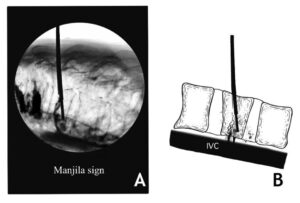
Figure 4: A: An antegrade venous drainage ( “inferior vena cavogram”) during vertebral phlebography (pre-cement injection ) and a rapid efflux of contrast from the inferior venacava. This lateral view contrast venogram reveals the surrogate path for extravasated bone cement that can potentially lead to a catastrophic pulmonary embolism (Manjila sign); B: Schematic representation of the pre/ paravertebral venous channel(s) that allow contrast drainage into the inferior vena cava before or after balloon inflation during kyphoplasty, with pedicle cannula in situ. Although the paravertebral veins drain mostly via azygous system, the fractures themselves or fragments compacted by balloon inflation can open up channels that lead to the anterior external vertebral venous plexus or some direct tributaries into the inferior vena cava (as shown in B), suggesting a huge risk of extravasated kyphoplasty cement following the same path resulting in a fatal pulmonary embolism.
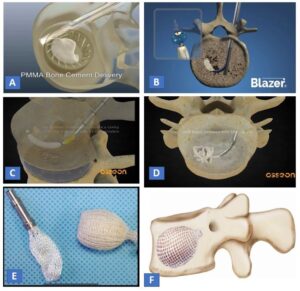
Figure 5: Various device modifications used to avoid cement extravasation. A; Benevue kyphoplasty with a sideways delivery of coil followed by PMMA bone cement delivery: KIVA implant after using steerable needle tip without ballooning. B. Blazer device with steerable tip in a standard flexible tip kyphoplasty method. C. Osseon fenestrated steerable tip kyphoplasty needle with inflation of a built- in / mounted banana shaped balloon. D. Osseon showcasing a viscosity- adjusted delivery of cement using unipedicular access though fenestrated curved tip kyphoplasty needle and. E Optimesh cage filled with compacted bone chips without cement injection, thereby obviating the risk of pulmonary embolism.
Management of PCE Cases
The management includes early diagnosis and treatment which includes hypotension, arrhythmia and oxygen desaturation. If the symptoms occur during surgery, abandon further cement injection and make the patient supine. If patient becomes symptomatic in the recovery area or after days/ weeks, the strategy should comprise of avoiding hypoxia and hypotension, before getting definitive radiological diagnosis of the extent and location of PCE using echocardiogram, CTA chest or MRI chest. [13]. Supplemental oxygen can be administered via facemask to maintain Pa O2>60 mm Hg and Sa O2>90%; a tracheal intubation and mechanical ventilation is to be performed if there is no improvement. If there is history of seizures, anticonvulsants should be added. Anticoagulation such as low‐molecular‐weight heparin/ enoxaparin/ Anti-Xc should be administered immediately to reduce the danger of pulmonary infarction and prevent delayed consequences of a retained thrombogenic foreign material. Using minimally invasive endovascular method, the cement can be snared out through the pulmonary artery, triscupid valve apparatus, into the inferior vena cava and pulled distally through the right common iliac vein [2,9,20]. If endovascular intervention is technically not feasible, an open thoracotomy/ sternotomy is needed, modified to suit atriotomy, inferior cavotomy, tricuspid annulotomy, repair of cardiac perforation, evacuation of pericardial effusion/ hematoma etc depending on the clinical situation.
Conclusion
The article highlights the perils of pulmonary cement embolism during a balloon kyphoplasty. It is reassuring for the spine surgeon to watch out for early PCE if he can visualize the perivertebral venous anatomy by doing a contrast phlebography intraoperatively before injection of cement. The management algorithm is outlined with a synopsis of improvised non-cement technology in kyphoplasty.
Conflict of Interest
The authors declared no potential conflicts of interest with respect to the research, authorship and/or publication of this article.
Acknowledgement
Acknowledge those who provided technical support during the study.
Consent to Participate
Informed consent was obtained from each participant prior to specimen collection.
Financial Disclosure
This research did not receive any grant from funding agencies in the public, commercial or not-for-profit sectors.
Data Availability
Data is available for the journal. Informed consents were not necessary for this paper.
Author’s Contribution
The authors contributed equally.
References
- Agko M, Nazzal M, Jamil T, Castillo-Sang M, Clark P, Kasper G. Prevention of cardiopulmonary embolization of polymethylmethacrylate cement fragment after kyphoplasty with insertion of inferior vena cava filter. J Vasc Surg. 2010;51:210-3.
- Bose R, Choi JW. Successful percutaneous retrieval of methyl methacrylate orthopedic cement embolism from the pulmonary artery. Catheter Cardiovasc Interv. 2010;76:198-210.
- Duan ZK, Zou JF, He XL, Huang CD, He CJ. Bone-filling mesh container versus percutaneous kyphoplasty in treating Kümmell’s disease. Arch Osteoporos. 2019;18;14(1):109.
- Greene DL, Isaac R, Neuwirth M. The eggshell technique for prevention of cement leakage during kyphoplasty. J Spinal Disord Tech. 2007;20:229-32.
- Hartman J, Granville M, Jacobson RE. Treatment of a high-risk thoracolumbar compression fracture using bilateral expandable titanium spinejack implants. Cureus. 2019;11(5):e4701.
- Hoppe S, Elfiky T, Keel MJ, Aghayev E, Ecker TM, Benneker LM. Lavage prior to vertebral augmentation reduces the risk for cement leakage. Eur Spine J. 2016;25(11):3463-9.
- Iwanaga J, Rustagi T, Ishak B, Johal J, David G, Reina MA, et al. Venous drainage of lumbar vertebral bodies: anatomic study with application to kyphoplasty, vertebroplasty and pedicle screw complications. World Neurosurg. 2020;137:e286-90.
- Jones JC, Miller JA, Sudarshana DM, Thompson NR, Benzel EC, Mroz TE. Predictors of favorable quality of life outcome following kyphoplasty and vertebroplasty. J Neurosurg Spine. 2019;24;31(3):389-96.
- Lamparello NA, Jaswani V, DeSousa K, Shapiro M, Kovacs S. Percutaneous Retrieval of an Embolized Kyphoplasty Cement Fragment From the Pulmonary Artery: A Case Report and Literature Review. J Radiol Case Rep. 2016;31;10(7):40-7.
- Laratta JL, Shillingford JN, Ha A, Lombardi JM, Reddy HP, Saifi C, et al. Utilization of vertebroplasty and kyphoplasty procedures throughout the United States over a recent decade: an analysis of the Nationwide inpatient sample. J Spine Surg. 2017;3(3):364-70.
- Luginbühl M. Percutaneous vertebroplasty, kyphoplasty and lordoplasty: implications for the anesthesiologist. Curr Opin Anaesthesiol. 2022;21(4):504-13.
- Martín-López JE, Pavón-Gómez MJ, Romero-Tabares A, Molina-López T. Stentoplasty effectiveness and safety for the treatment of osteoporotic vertebral fractures: a systematic review. Orthop Traumatol Surg Res. 2015;101(5):627-32.
- Potet J, Weber-Donat G, Curis E, Arnaud FX, Thome A, Valbousquet L, et al. Incidence of pulmonary cement embolism after real-time CT fluoroscopy-guided vertebroplasty. J Vasc Interv Radiol. 2013;24(12):1853-60.
- Radcliff KE, Reitman CA, Delasotta LA, Hong J, DiIorio T, Zaslavsky J. Pulmonary cement embolization after kyphoplasty: a case report and review of the literature. Spine J. 2015;10:e1-5.
- Rothermich MA, Buchowski JM, Bumpass DB, Patterson GA. Pulmonary cement embolization after vertebroplasty requiring pulmonary wedge resection. Clin Orthop Relat Res. 2014;472(5):1652-7.
- Vallgren S, Sigurdsson GH, Moberger G, Christenson JT. Influence of intravenous injection of sclerosing agents on the respiratory function. Acta Chir Scand. 1988;154:271-6.
- Venmans A, Klazen CA, Lohle PN, van Rooij WJ, Verhaar HJ, de Vries J, et al. Percutaneous vertebroplasty and pulmonary cement embolism:results from VERTOS II. AJNR Am J Neuroradiol. 2010;31:1451-3.
- Wang AC, Fahim DK. Safety and efficacy of balloon kyphoplasty at 4 or more levels in a single anesthetic session. J Neurosurg Spine. 2018;28(4):372-8.
- Wang C, Fan S, Liu J. Basivertebral foramen could be connected with intravertebral cleft: a potential risk factor of cement leakage in percutaneous kyphoplasty. Spine J. 2014;14:1551-8.
- Zhao Y, Liu T, Zheng Y, Wang L, Hao D. Successful percutaneous retrieval of a large pulmonary cement embolus caused by cement leakage during percutaneous vertebroplasty: case report and literature review. Spine. 2014;39(26).
Author Info
Melissa Kohner1




1Great Lakes Bay Health Centers, Bay City MI, USA
2Swanson School of Engineering, University of Pittsburgh, Pittsburgh PA, USA
3Department of Neurosurgery, Garden City Hospital, Garden City, Michigan, USA
4Government Medical College Kozhikode, Kerala, India
*Correspondence author: Sunil Manjila, MD, Department of Neurosurgery, Garden City Hospital, Garden City, Michigan, USA; Email: [email protected]
Copyright
Melissa Kohner1




1Great Lakes Bay Health Centers, Bay City MI, USA
2Swanson School of Engineering, University of Pittsburgh, Pittsburgh PA, USA
3Department of Neurosurgery, Garden City Hospital, Garden City, Michigan, USA
4Government Medical College Kozhikode, Kerala, India
*Correspondence author: Sunil Manjila, MD, Department of Neurosurgery, Garden City Hospital, Garden City, Michigan, USA; Email: [email protected]
Copyright© 2024 by Kohner M, et al. All rights reserved. This is an open access article distributed under the terms of the Creative Commons Attribution License, which permits unrestricted use, distribution, and reproduction in any medium, provided the original author and source are credited.
Citation
Citation: Kohner M, et al. Intra-Vertebral Contrast Phlebography During Balloon Kyphoplasty: A Cautionary Tale of Using Antegrade Inferior Vena Cavogram in Preventing Pulmonary Cement Embolism. Jour Clin Med Res. 2024;5(3):1-8.



